Topic outline
-

The ESD Module Part 3 "Sustainability and entrepreneurship in the European market" consists of the following 14 lectures:
State of the Art in Globalisation and Industrialisation in the Textile and Clothing Industry
International Procurement of Textiles and Clothing for the European Retail Market
New Strategies for Sustainable Textiles and Fashion in the European Market
Chances and Risks of Slow Fashion Strategies and a Circular Economy in the European Market
All learning materials provided are for non-commercial use only and are licensed under "CC-BY-NC" from Creative Commons.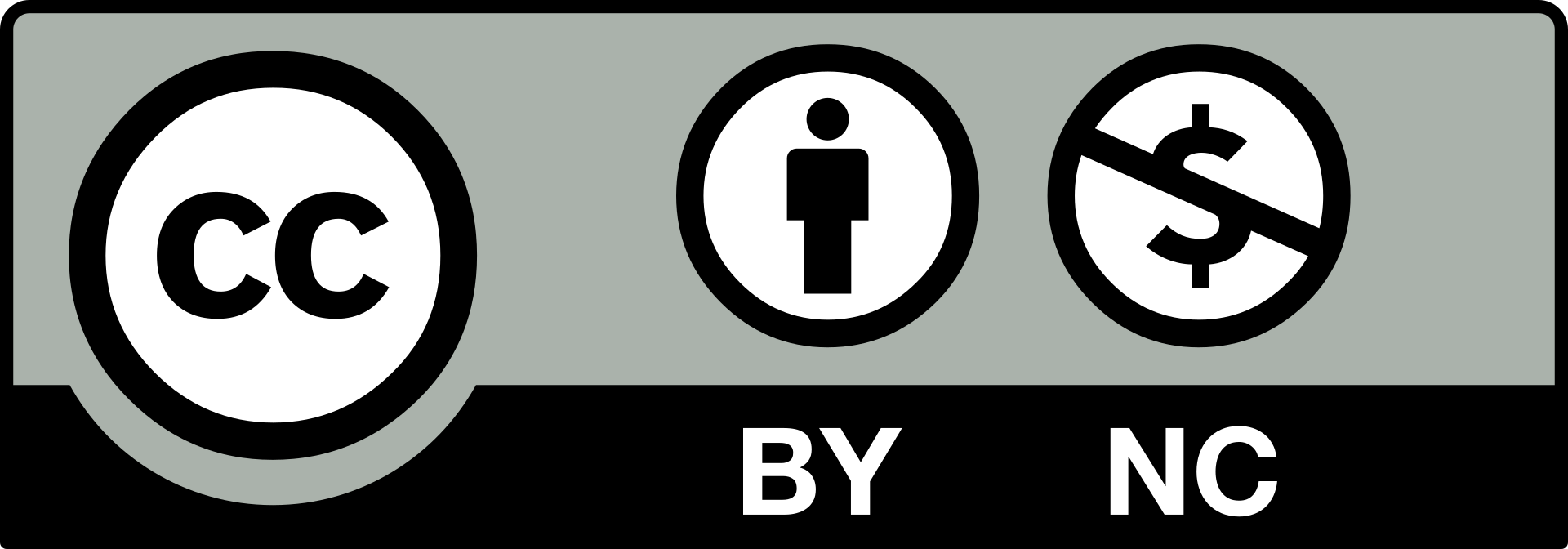
-

Falling prices for clothes relative to other consumer goods, diminishing quality of apparel and rise in households’ disposable income has motivated consumers to shift from ‘living without’ to buying more fashion items over the last decades. This development has further accelerated through the advent of e-commerce and the opportunity to immediately and easily purchase various fashion from all over the world at a low price. This has resulted in a “throwaway culture” with many clothes being disposed before their effective lifetime has ended.
Consumers have a nearly endless amount of opportunities nowadays. Products are quite similar and there are hardly significant differences in quality or price. Choices are based on more than traditional variables, thus, there are various factors that impact consumer decision making. Consumers’ decisions are found to be highly context dependent. Decisions can be difficult since there are many motives, many options, conflicting values, difficult trade-offs, etc. Consumers try to find a compromise between the desire to make an accurate decision and the desire to minimize cognitive effort. Sometimes consumers prefer accurate decisions, and other times easy, fast, justifiable choices are appreciated. Time pressure also affects how much information is gathered and processed. If consumers have time pressure, less information is searched for. Furthermore, emotions play a crucial role since they provide immediate evaluation on the “goodness” or “badness” of a product or service. People especially rely on their emotions when the decision is difficult, when there is a limited amount of information or when they feel the emotions are relevant. Consumption is also used as an identity claim, a signal for values or a tool for regulating mood. The increasing power of social networks means that consumers’ choices are based more and more on identity, gaining social currency and self-branding.
Consumers follow a certain process when deciding for the purchase of a product or service. One popular and comprehensive approach to depict the consumer decision process is the Engel-Kollat-Blackwell (EKB) Model that comprises five different stages: need recognition (consumers realize that they need something), information search (consumers start an information search about different alternatives to satisfy the need) alternative evaluation (consumers make a final decision and look for the best deal), purchase decision (consumers make a purchase intention to buy a certain product, but may do not close a deal) and post-purchase (consumers evaluate and review the product).
Regarding the channel, online sales (after a previous strong increase) have entered a stagnation mode. However, with the advent of Covid, online sales heavily increased. Overall, during the pandemic, all forms of fashion acquisition decreased. Consumers chose to spend less on apparel, reduce discount and impulse purchases. Many consumers stopped buying clothes because there was no longer a need to dress up. Furthermore, sustainable forms of fashion consumption such as ethically-made and environmentally-friendly new or second-hand apparel, swapping, renting, and tailoring apparel decreased.Marcus Adam
Content:
-
Please find below the PDF document of the lecture “Fashion Consumption in the European Market”.
The document contains notes by the author.
-
Please find below the Powerpoint presentation of the lecture “Fashion Consumption in the European Market”.
The presentation contains notes by the author.
-
Here you can download all documents of the lecture in a bundle:
-
Please give us your Feedback on the Lecture “Fashion Consumption in the European Market”.
-
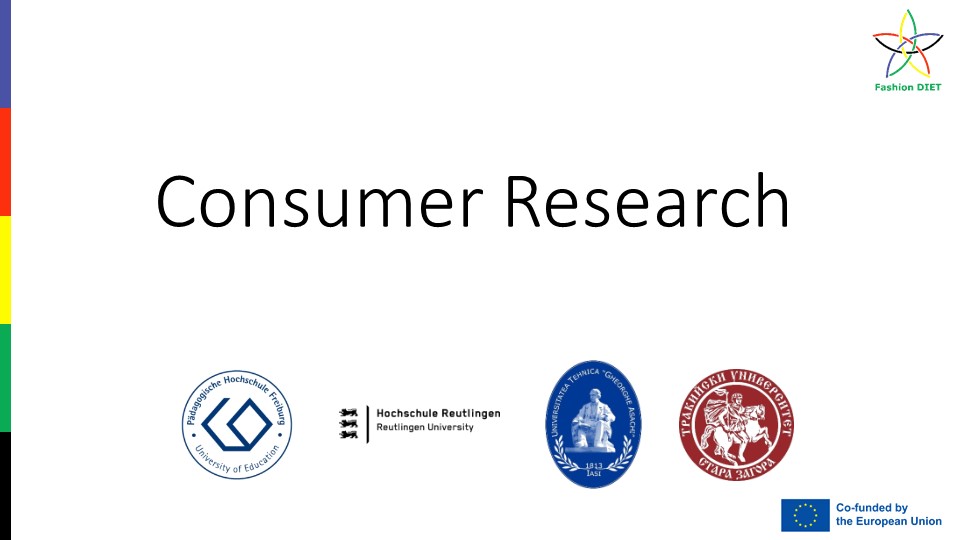
Companies must produce bundles of benefits that consumers will view as valuable. Developing and implementing a marketing strategy involves four stages: Identifying and evaluating market opportunities, analyzing market segments and selecting target markets, Planning and implementing a marketing mix that will provide value to customers and meet organizational objectives, Analyzing firm performance. For this purpose, market research is conducted. Marketing research is the application of the scientific method in searching for the truth about marketing phenomena. In market research, scientific method is the way researchers go about using knowledge and evidence to reach objective conclusions about the real world.
Marketers must consider measurement and attitude Scaling, be familiar with different level of scales, and understand the concept and the differences between reliability and validity. Market research can be conducted as qualitative or quantitative research. Qualitative marketing research addresses marketing objectives through techniques that allow the researcher to provide elaborate interpretations of market phenomena without depending on numerical measurement. Qualitative research is often used in an exploratory research context, e.g. in order to develop ideas or concept testing. It is useful, when it is difficult to develop specific and actionable decision statements or research objectives, the research objective is to develop a detailed and in-depth understanding of some phenomena, the research objective is to learn how consumers use a product in its natural setting or to learn how to express some concept in colloquial terms, the behavior the researcher is studying is particularly context-dependent, or a fresh approach to studying the problem is needed. Personal interviews and focus group interviews are the most common method to collect qualitative data.
Quantitative research, on the other hand, addresses research objectives through empirical assessments that involve numerical measurement and statistical analysis. The most common method to collect quantitative data are surveys in different forms with a multiple set of different question types. Observations are another important tool in market research. The advantages of observations are that communication with respondents is not necessary, data is not distorted by self-report bias (e.g., without social desirability), there is no need to rely on respondents’ memory, nonverbal behavior data may be obtained, certain data may be obtained more quickly, environmental conditions may be recorded, and it may be combined with survey to provide complementary evidence. However, observations have some limitations. They cannot observe cognitive phenomena such as attitudes, motivations, and preferences. Even though observation can describe the event that occurred, they cannot explain why the event occurred. Finally, the observation period generally is short because long periods are expensive or even impossible.Marcus Adam
Content:
-
Please find below the PDF document of the lecture “Consumer Research”.
The document contains notes by the author.
-
Please find below the Powerpoint presentation of the lecture “Consumer Research”.
The presentation contains notes by the author.
-
Here you can download all documents of the lecture in a bundle:
-
Please give us your Feedback on the Lecture “Consumer Research”.
-

The internet and mobile technologies have allowed greater communication between people in different countries. Accordingly, the accessibility of information has eased which opens up new opportunities for sustainable development. Media can play a crucial role in this context. They provide understanding of geographical knowledge to people by reporting what is happening in which country right now, and inform about is the background and impact. They report and educate people about activities and behavior that negatively impact our ecological environment and explain the reasons. Furthermore, media educate about environmental protection, spread sustainability information through different media channels (internet articles, printed articles, social media coverage, TV, online streams, podcasts and other audio formats…) to reach different groups in a society. Media, moreover, disseminate vocational and professional information, and educate people about the role they play within a society to empower them. Media can also create awareness of disastrous events in faraway parts of the world, so that people in any country are quickly made aware of natural disasters and can provide help and/or donate. This is greatly needed since in some countries there is more development aid than government spending.
In order to report and educate people on sustainability, journalist of any media outlet need to be educated in sustainability themselves. This is challenging since the field of sustainability is complex and holistic with many diverse information and interrelated parts: deep knowledge is needed. For this reason, sustainability has to be implemented in the curricula of any media and communication study program. However, the level of curricular integration of sustainability aspects in the field of media and communication is low. In most cases, sustainability remains an abstract guiding principle that is not translated into a dedicated course offer. Given the social relevance and responsibility of the discipline, sustainability communication should be more strongly institutionalized, in terms of curricular integration, and through the development of respective study programs.
With the advent of the internet and new technologies, e-commerce has appeared and plays a significant role today. It brings consumers the convenience to buy products at any place and at any time, allows them a great choice of products from all parts of the world, increases availability of rare items, and opens business opportunities also for SMEs with tight budgets. The Covid-19 pandemic has further boosted online shopping since many physical stores were forced to start selling online. This trend is unlikely to be reversed in the future, however, brings along severe negative environmental impact.
In general, there are three main categories of environmental effects of e-commerce: First-order effects such as the availability of an ICT infrastructure required (PCs, mobile phones, servers, routers, etc.) which causes material flows, the use of hazardous substances, energy consumption, and electronic waste. Second-order effects such as productivity, transportation, land use, and third-order effects that result in rebound effects.
Marcus Adam & Jochen SträhleContent
-
Please find below the PDF document of the lecture “The Impacts of E-Commerce and Media on Sustainable Fashion”.
The document contains notes by the author.
-
Please find below the Powerpoint presentation of the lecture “The Impacts of E-Commerce and Media on Sustainable Fashion”.
The presentation contains notes by the author.
-
Here you can download all documents of the lecture in a bundle:
-
Please give us your Feedback on the Lecture “The Impacts of E-Commerce and Media on Sustainable Fashion”.
-
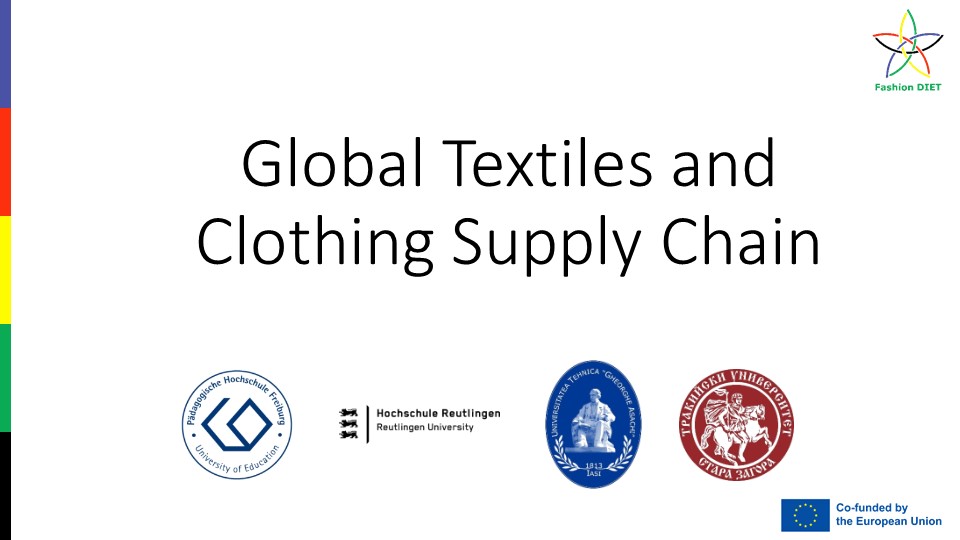
Globalization is the process of interaction and integration among people, companies, and governments worldwide. Globalization has been taking place for hundreds of years, but has sped up egregiously over the last half-century. Globalization has resulted in increased international trade, companies operating in more than one country, greater dependence on the global economy, freer movement of capital, goods, and services, and recognition of specific companies worldwide. Global sourcing strategies have emerged that involve worldwide geographically fragmented locations. In practice, apparel retailers approach their outsourcing and offshoring activities in three ways: direct sourcing, sourcing intermediaries, or sourcing hubs.
The globalization of textile supply chains has a tremendous negative environmental impact. It has led to a high usage of chemicals in the producing countries and a high input of water which is often discharged unfiltered into waterways. Wastewater pollution has increased within processing and raw materials stages due to the use of nutrients and fertilizers. Furthermore, long-distance transport is required to move the finished products from the factories (located in low-labor-cost countries) to the consumer in a developed country.
In light of the globally dispersed apparel supply chain network the intense involvement of lower-tier suppliers in apparel supply chains makes it complicated to manage environmental and social issues because the buying firms lack of information and have less impact on lower-tier suppliers. Therefore, the operationalization of global supply chain networks (comprising multi-tier suppliers and stages) is a highly challenging task and needs strategic management actions.
Especially in the last couple of years, the global economic development poses new requirements for companies` supply chain management. Emerging challenges comprise demand volatility, production volatility, transportation issues, perishability, transparency, lead times, the availability of raw materials, and the popularity of fast fashion.Marcus Adam & Jochen Strähle
Content:
-
Please find below the PDF document of the lecture “Global Textiles and Clothing Supply Chain”.
The document contains notes by the author.
-
Please find below the Powerpoint presentation of the lecture “Global Textiles and Clothing Supply Chain”.
The presentation contains notes by the author.
-
Here you can download all documents of the lecture in a bundle:
-
Please give us your Feedback on the Lecture “Global Textiles and Clothing Supply Chain”.
-
Topic 5: State of the Art in Globalisation and Industrialisation in the Textile and Clothing Industry
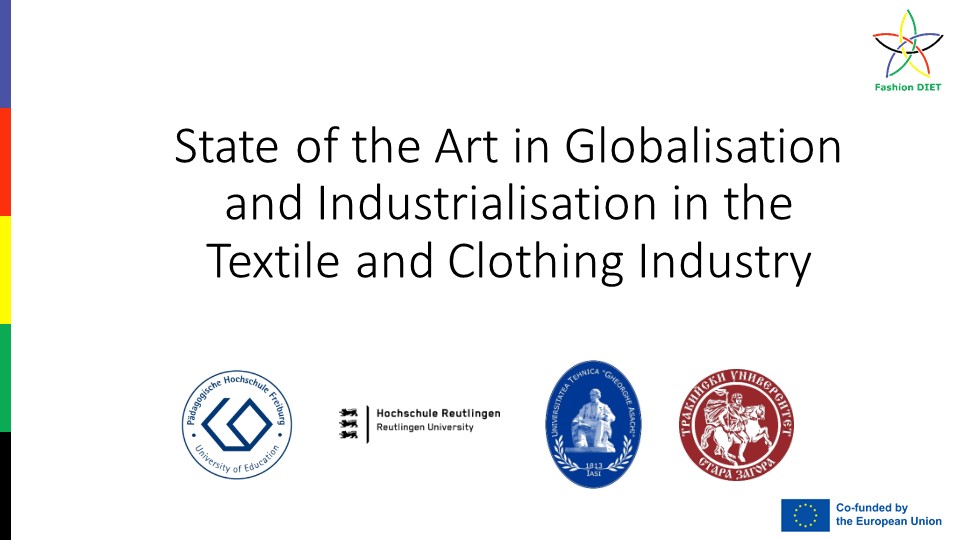
Globalization is the process of interaction and integration among people, companies, and governments worldwide. Globalization has been taking place for hundreds of years, but has sped up enormously over the last half-century. Thus, when talking about globalization, we usually refer to the global development from the 1970s until today. The globalization process has i.e. resulted in significantly increased international trade, companies operating in more than one country, greater dependence of every country and individuals on the global economy, freer movement of capital, goods, services and humans, and the recognition of specific companies worldwide (global brands).
One reason for globalization is the significant decline of transport and communication costs over the last decades. As a result, exports of goods and services count for more than 25 percent of the global Gross Domestic Product today. This development has been accelerated through the establishment of intergovernmental organizations like the World Trade Organization (WTO), International Monetary Fund (IMF) or the United Nations Conference on Trade and Development (UNCTAD) that promote free trade between countries. While these economic institutions aim at fostering economic cooperation worldwide, a similar effort has been made regionally through multinational trading blocs. Trading blocs are a group of countries that decide to have common trading policies for the rest of the world in terms of tariffs and market access. Additionally, they give preferential treatment or benefits to each other within the bloc.
Another reason for globalization is the significant growth of the world population over the last decades which has led to a greater global workforce. Given the cheap transportation costs and the mitigated transnational trade barriers, this workforce can be globally accessed and utilized. Main profiteer of this development are especially the developed countries where wealth has increased while annual working hours of individuals declined. The advent of the internet plays a further decisive role for globalization over the last two decades. This has led to the rise of e-commerce and the immediate availability of any product independent of its origin, to more intercultural and interpersonal exchange across borders, a reduction of prejudices between individuals and nations, and more flexibility for freely moving and working in different countries simultaneously. Furthermore, Foreign Direct Investment (FDI) is an important channel for the transfer of technology between countries and promotes international trade, can create jobs and skills for local people and the money created by investment can be spent on education, health and infrastructure.
However, globalization also has a number of negative effects. MNCs with their massive economies of scale, may drive local companies out of business. If it becomes cheaper to operate in another country, the MNC might close down the factory and make local people redundant. Furthermore, globalization has facilitated mass production and leads to overconsumption. Globalization is also viewed by many as a threat to the world's cultural diversity: It is feared it might drown out local economies, traditions and languages.
Marcus Adam & Jochen Strähle
Content:
-
Please find below the PDF document of the lecture “State of the Art in Globalisation and Industrialisation in the Textile and Clothing Industry”.
The document contains notes by the author.
-
Please find below the Powerpoint presentation of the lecture “State of the Art in Globalisation and Industralisation in the Textile and Clothing Industry”.
The presentation contains notes by the author.
-
Here you can download all documents of the lecture in a bundle:
-
Please give us your Feedback on the Lecture “State of the Art in Globalisation and Industrialisation in the Textile and Clothing Industry”.
-
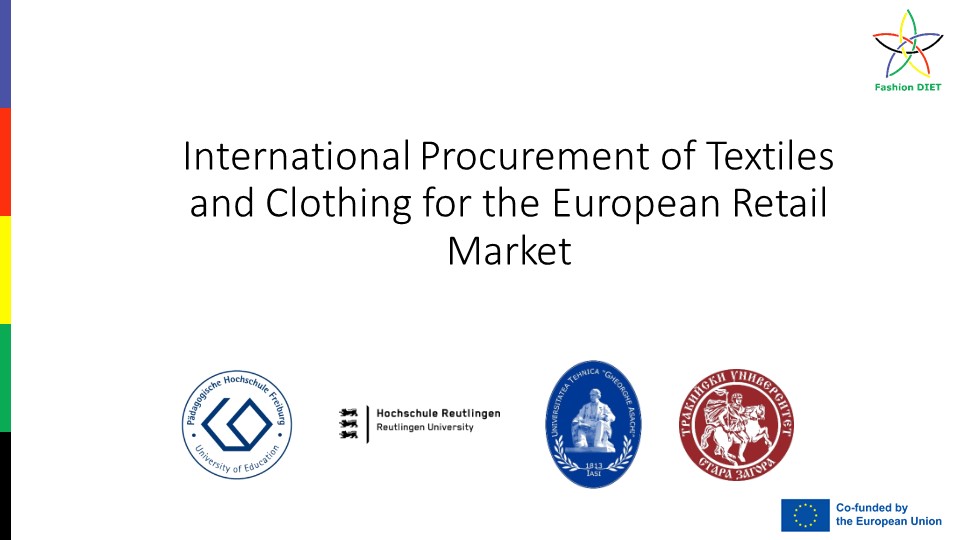
The sustainability challenges of textile and clothing are very closely related to the rapid globalization of trade in the recent decades. Arising opportunities and the severe global competition have motivated companies to put many efforts into reducing manufacturing costs by outsourcing their production to developing countries with low wages.
In practice, apparel retailers approach their outsourcing and offshoring activities in three ways: through direct sourcing from suppliers, through sourcing intermediaries, or via sourcing hubs. The simplest way of sourcing directly from suppliers is through the headquarters of an apparel retailer who are in direct contact with their suppliers and hence obtain better control over the manufacturing process. Moreover, apparel retailers set up subsidiaries in the respective sourcing countries, so called sourcing hubs/offices or international purchasing offices. Lastly, apparel retailers usually employ (import or export) sourcing intermediaries, also typically referred to as e.g. sourcing agents or full-service vendors who usually bridge apparel retailers in developed countries and manufacturers in developing countries. Governments in developing countries have been encouraged by international institutions to put economic growth before stronger environmental and social regulation.
The main problem in keeping the textile supply chain transparent for all of its related actors is the extraordinarily diversification of apparel products. Social movements and journalists collect experiences, document sweatshop and unsustainable production circumstances. This politicization threats the reputation of big brands and creates drivers for more sustainable sourcing strategies. As a result, resources are mobilized, collaborations developed, new standards issued, and eco-sourcing encouraged. On the other hand, the globally stretched, complex, and fragmented supply chains come along with enormous governance difficulties. Barriers to sustainable sourcing in the fashion industry are undersupply of sustainable raw materials, shortage of superior quality raw materials, complex material structure and composition, weak partnerships and integration between partners, absence of suitable supplier training and reward system, and poor commitment and asymmetric information sharing from buyer/customer. Furthermore, cost of sustainable raw materials, rise in cost of investment, uncertain return on investment, cost of eco-friendly packaging, resistance to upskill and knowledge sharing may lead po continued misunderstandings throughout the entire supply and demand chain. Other barriers comprise a lack of eco-literate and skilled employees, insufficient commitment from top management, hard transition to new business models, inadequate infrastructure, disperse customer perceptions, and limited support from governing authorities.
Marcus Adam & Jochen Strähle
Content:
-
Please find below the PDF document of the lecture
"International Procurement of Textiles and Clothing for the European Retail Market".
The document contains notes by the author.
-
Please find below the Powerpoint presentation of the lecture “International Procurement of Textiles and Clothing for the European Retail Market”.
The presentation contains notes by the author.
-
Here you can download all documents of the lecture in a bundle:
-
Please give us your Feedback on the Lecture “International Procurement of Textiles and Clothing for the European Market”.
-

Since the early 1970s and the development of globalization outsourcing gained increased attention. Outsourcing refers to arrangements between a company and its independent suppliers to manufacture components or to provide services according to defined specifications. Single or multiple steps of the manufacturing process can be transferred to a foreign contractual partner (pre-production, final production, refining or complete production). Benefits include cost savings (especially in labor-intensive production processes in low-wage countries), savings in taxation, lower energy costs, access to raw material, and the opportunity to concentrate on the firm`s core competences (e.g. product design, marketing, etc.). This has led to complex networks that companies operate in.
Network theory serves as a suitable approach to understand this complexity. It departs from the assumption that markets are constituted of networks. A network consists of a set of actors or nodes along with a set of ties of a specified type (such as friendship) that link them. The ties are interconnected through shared end points to form paths that indirectly link nodes that are not directly tied. The pattern of ties in a network yield a particular structure, and nodes occupy positions within this structure. This means that companies are not isolated but embedded and connected through relationships with other units or actors, which they exchange knowledge, goods or information with. Networks present essential conduits of information and know-how and provide firms access to useful information and resources. This implies that a company is not able to implement a certain strategy completely independent but needs to consider other expectations, requirements, or opinions. Each network is characterized by a (potentially) varying network density which describes the degree of interconnection among the various parties within the network and represents the strength of relationship between the different nodes.
Networks can be illustrated in form of a map. It illustrates the relationships of the different parties within the environment of the respective firm. Network mapping helps companies to cope with relation complexity, helps to identify the different and the most important linkages and nodes, and allows to build awareness of the company´s position. Looking at an illustration of its network will make it easier for a company to set the scope of its strategy and enable them to focus on business efforts.
Trustworthiness is essential to develop and maintain mutual, long-term relationships. When trust exists, uncertainty is reduced and individuals are more willing to share resources and collaborate. Creating trust between partners is therefore a governance mechanism that undergirds the establishment of network ties. Trust may evolve from an cognitive or emotional direction.
The process of establishment and development of relationship over time can occur in incremental stages in their evolution. The stages are marked by factors which determine the reduction or increase of uncertainty and commitment between both parties. Establishing relationships is not an inevitably developing process, as there is no certainty for a company to evolve and proceed to the next stage. Instead, failure or regress of development might occur.
Marcus Adam
Content:
-
Please find below the PDF document of the lecture “Supplier Relationships”.
The document contains notes by the author.
-
Please find below the Powerpoint presentation of the lecture “Supplier Relationships”.
The presentation contains notes by the author.
-
Here you can download all documents of the lecture in a bundle:
-
Please give us your Feedback on the Lecture “Supplier Relationship”.
-

Global sourcing gained increasing attention during the early seventies when the advantages of offshore production have been realized, particularly in terms of costs as the most dominant driving factor. Primary reasons for outsourcing and offshoring activities are lower prices, access to locally unavailable products, technologies, scarce resources, higher quality, increase of supplier base, and the opportunities to develop a foreign market. This has led to different integration levels of sourcing ultimately resulting in global sourcing strategies that involves worldwide geographically fragmented locations. Therefore, the operationalization of global supply chain networks comprising multi-tier suppliers (first- and lower tier suppliers) is a highly challenging task and needs strategic management actions calling for the need of Supply Chain Management (SCM) in order to achieve purely economic objectives: lower costs, increased customer value and satisfaction, and finally competitive advantage. Lower-tier suppliers are considered being less responsive for social and environmental issues and have weak relationships with the downstream supply chain due to the complex and long supply chains. In general, there is a substantial lack of visibility as they indicate that apparel retailers might even not know the suppliers who manufacture their garments what can induce considerable social risks such as the use of child labour.
The integration of economic, ecological and social aspects of business practices and theory to SCM will result in Sustainable Supply Chain Management (SSCM). SSCM demands a broader perspective of SCM. One concept that concisely shaped the literature on sustainability and its operationalization is the assessment of a firm`s performance under the umbrella of the triple bottom line (TBL), which recommends the simultaneous commitment to environmental, social, and economic dimensions. Managing sustainability risks and reputation, meeting consumer demands and stakeholder pressures, or gaining competitive advantages are among the primary motivations for focal companies to approach SSCM however, there are notable barriers for efficient and effective SSCM such as higher costs, coordination complexity and insufficient or missing communication in the supply chain. Therefore, supplier evaluation requires specific governance mechanisms and supply chain management capabilities.
In order to specifically address social issues in the supply chain, the concept of Social Sustainable Supply Chain Management has emerged. It comprises three basic strategies that ultimately have an impact on social performance outcomes in supply chains: communication, supplier development, and compliance strategy. Social performance metrics addressed by Social Sustainable Supply Chain Management are particularly human rights, unfair wages, excessive working time, child/forced labour, unhealthy/dangerous working conditions, discrimination, diversity, and treatment of animals.
Marcus Adam & Deniz Köksal
Content:
-
Please find below the PDF document of the lecture “Social Risk Management in Fashion Supply Chains”.
The document contains notes by the author.
-
Please find below the Powerpoint presentation of the lecture “Social Risk Management in Fashion Supply Chains”.
The presentation contains notes by the author.
-
Here you can download all documents of the lecture in a bundle:
-
Please give us your Feedback on the Lecture “Social Risk Management in Fashion Supply Chains”.
-
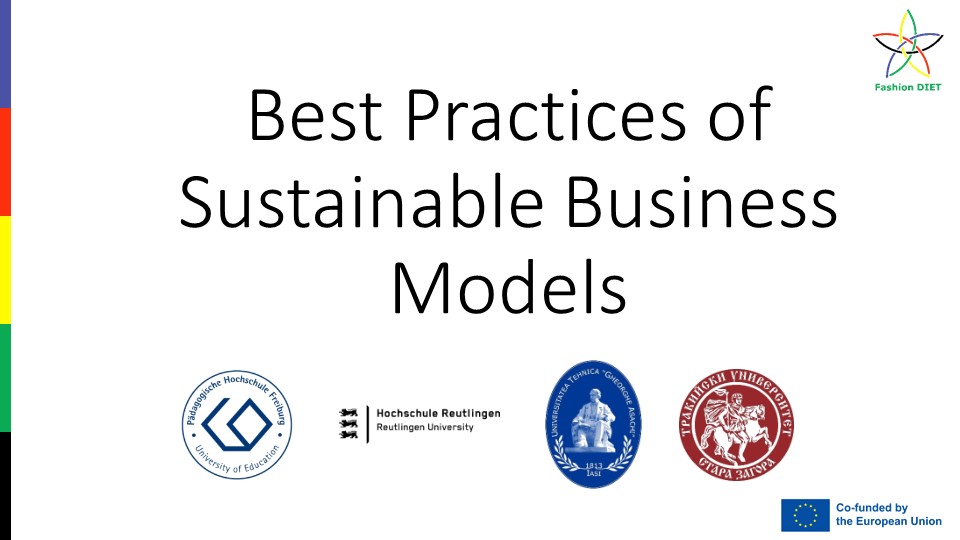
Many clothes are disposed before their effective lifetime has ended. This phenomenon is frequently referred to as “throwaway culture”, a result of consumers` greed for constantly buying more fashion items and fashion retailers satisfying this hunger by permanently flooding the market with new clothes at a very low price.
Some fashion companies have started to address these challenges by applying ecofriendly technologies and integrating sustainability aspects into their supply chain management. However, as these approaches have turned out to be insufficient to achieve an ecological sustainable transformation of the fashion industry, sustainable business models have increasingly gained attention. In this context, Product-Service Systems (PSS) have emerged as a potential way of solving the sustainability challenge. Instead of selling solely tangible products, PSS shift the focus on fulfilling customers’ final needs through offering complementary service elements. This decouples customer satisfaction from material consumption and entails economic dematerialization as fewer products are manufactured and, hence, fewer resource and material inputs for corporate value creation are required.
The seminal tripartite classification of PSS divides PSS into three different types: (1) Product-oriented: Products are sold in a traditional manner but supplemented by extra services, such as after-sales services, that ensure long-term functionality. Examples are repair services, offers to take-back used garments or Make-it-yourself models. (2) Use-oriented: The use or functionality of a product is sold while the ownership of the product remains at the company that offers it. Examples comprise models to rent, lease or swap clothes. (3) Result-oriented: The company sells a result, a capability, or a competency that underlies a product such as consultancy or digital clothes.
Especially a mushrooming of providers that offer services to rent clothes can be observed in the market today and have gained popularity over the last years. These models significantly differ in terms of value proposition, channels and cost-revenue streams: Some firms directly rent clothes to customers for a certain period of time either for a fixed fee or a membership fee (e.g. monthly) via an online store. Others are fashion libraries that rent clothes through a permanent physical store. Furthermore, peer-to-peer renting (e.g. providers of online platforms) have seen a raise, and B2B offers (e.g. renting providers of working clothes) are already anchored in the clothing industry for a longer time.
Even though such initiatives have recently gained some attention, there are many barriers that prevent consumers from renting fashion such as hygiene concerns, the stigma of used goods, predominant consumption habits, the lack of ownership inherent to renting, a general lack of trust in both the offer and the provider, and the overall benefit/cost-ratio. There are furthermore internal organizational barriers that hamper PSS diffusion since PSS implementation calls for a fundamental conversion of existing corporate strategies, structures, and corporate cultures. Service offers significantly differ from the predominant way of manufacturing and selling clothes. Thus, even though, PSS present a promising solution for the industry`s environmental challenge, its future diffusion and potential still remains uncertain.
Marcus Adam & Jochen Strähle
Content
-
Please find below the PDF document of the lecture “Best Practices of Sustainable Business Models”.
The document contains notes by the author.
-
Please find below the Powerpoint presentation of the lecture “Best Practices of Sustainable Business Models”.
The presentation contains notes by the author.
-
Here you can download all documents of the lecture in a bundle:
-
Please give us your Feedback on the Lecture “Best Practices of Sustainable Business Models”.
-

The fashion industry is extremely resource-intensive and causes significant environmental and social impact. Many consumer studies indicate that consumers want more transparency regarding companies` impact on the environment and society. In recent years, more and more fashion firms have started to address this demand and disclose non-financial information about their business activities. Transparency involves the corporate disclosure of the names of the suppliers involved in producing the firm’s products; information about the sustainability conditions within these suppliers’ facilities and the buying firms’ purchasing practices. Transparency has also benefits for the company. It reduces negative market signals regarding environmental and social impacts, facilitates the assessment of regulatory and voluntary compliance, and enhances the efficiency and quality of SSCM.
Until now, companies have been able to use different frameworks for their reporting, such as the German Sustainability Code or the standards of the Global Reporting Initiative (GRI). In order to improve the comparability and quality of sustainability reporting, companies are now required to use uniform reporting standards which, among other things, specify the information to be reported and the type of reporting (e.g. structure of the report). The standards will be issued by the EU Commission by way of delegated acts; for SMEs, standards are envisaged which take into account the special features of these companies
According to the revised CSR Directive by the EU the group of companies that will have to report on non-financial aspects in the future is growing strongly. In principle, all companies listed on a regulated market in the EU (with the exception of micro-entities), as well as large non-capital-market-oriented companies and most banks and insurance companies, will be required to report on non-financial indicators in the future, thus contributing to greater transparency on sustainable aspects.
Marcus Adam, Jochen Strähle & Malte WesselsContent:
-
Please find below the PDF document of the lecture “Transparency in Fashion Business”.
The presentation contains notes by the author.
-
Please find below the Powerpoint presentation of the lecture “Transparency in Fashion Business”.
The presentation contains notes by the author.
-
Here you can download all documents of the lecture in a bundle:
-
Please give us your Feedback on the Lecture “Transparency in Fashion Business”.
-

Fastness, newness and cheapness have become the most critical determinants for success in the mainstream fashion industry. However, this business model is extremely resource-intensive and causes significant environmental impact. In recent years, more and more fashion firms have started to address this problem and adopted environmental standards to produce more sustainable clothes. In order to solve this challenge, a clearly defined and executed strategy is needed. Strategic management embraces the formulation and implementation of the major goals and initiatives of a company on behalf of stakeholders. It is based on the consideration of resources and an assessment of the internal and external environments in which the company operates. Strategies are needed to set direction, focus effort, and the company, and provide consistency or guidance in response to environmental changes.
Fashion retailers, that want to implement a sustainability system in their stores, need to develop a clear long-term oriented strategy and define a plan of action to meet the strived goal. Based on the strategy, different data should be monitored and analyzed to prioritize efficiency initiatives by return on investment. This includes ongoing reports on contracts, market changes and opportunities. Next, energy assessments in a sample of stores should be deployed. Stores have to be organized in categories such a building type and age or by equipment which is installed. To be able to prepare a wide visibility into disparate data sources to internal and external stakeholders, energy and resource consumption data has to be collected and reports need to be generated. In a next step, energy and resource data has to be aggregated, centralized in a software and reviewed by remote energy experts to discover inefficiencies and recommend initiatives to optimize processes or equipment. Finally, supplier information should be analyzed in order to identify potential risks.
Another strategic approach towards sustainable retail is the development and implementation of Product-Service Systems. Instead of selling solely tangible products, PSS focus on fulfilling final customer needs through offering complementary service elements. PSS contradict the traditional, linear fashion business model: Implementation requires new distribution channels, revenue streams, logistics and expertise. Mastering two incompatible business models is challenging and involves the risk of establishing tomorrow’s business at the expense of today’s, especially as the present business model is working well for most fashion firms. This trade-off is referred to as “ambidexterity”. There are two basic strategic approaches to solve this challenge. First, spatial separation can be used, which means that the PSS business model is put into an autonomous and independent unit with own brand name, value chain, and organizational structures. The second strategic approach is temporal separation: The PSS business could be started in a separate unit and gradually be integrated into the main business over time.
Marcus Adam & Jochen SträhleContent:
-
Please find below the PDF document of the lecture “Green Fashion Retail Strategies”.
The presentation contains notes by the author.
-
Please find below the Powerpoint presentation of the lecture “Green Fashion Retail Strategies”.
The presentation contains notes by the author.
-
Here you can download all documents of the lecture in a bundle:
-
Please give us your Feedback on the Lecture “Green Fashion Retail Strategies”.
-
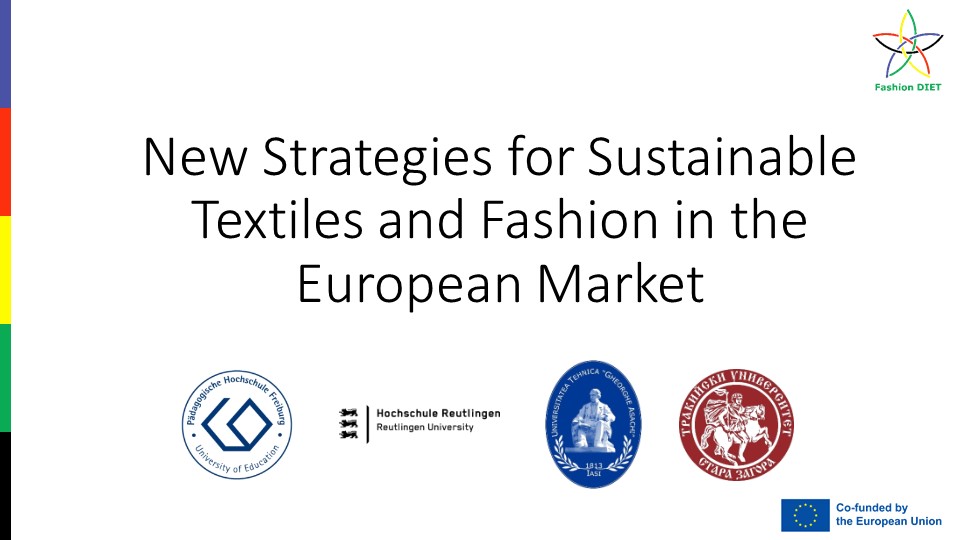
The fashion industry calls for new sustainable solutions to improve its ecological footprints. The predominant business model of today’s fashion industry is based on product obsolescence, with fashion retailers constantly presenting new fashion lines at a low price to a mass market. This causes significant environmental consequences as it implies high input of energy, water, pesticides, and harmful chemicals and generates vast volumes of waste. It furthermore, promotes a “throwaway culture” among consumers with garments disposed and replaced before their effective lifetime has ended. In recent years, more and more fashion firms have started to address this problem and adopted different Corporate Sustainability (CS) initiatives. These approaches vary a lot regarding commitment and engagement, from “greenwashing” to strategies that aim at transforming the predominant way to do business.
Advanced Corporate Sustainability strategies of organizations are based on different cornerstones such as transparency, comprehensive communication, disclosure of nonfinancial information, stakeholder dialogue, tolerance for failure, and organizational learning. Particularly Employees play decisive role for CS. A company cannot exist without employees: they need to support the CS directive and put it into actual practice. Huge potential for CS lies in employees: Many live a sustainable lifestyle in their private lives and like to transfer their way of living to their professional life. Furthermore, employees are the major point of intersection between firm and customers and thus represent the firm`s values in the eye of the customer. If an organization wants to be recognized as sustainable and educate its customers towards more sustainable behavior, it is largely up to the employees to transfer sustainable values and attitudes to the customers in a credible way. This especially applies to firms with a business model that is based on a significant service component like fashion retailers. Furthermore, many employees bring in a lot of education and experience that could and should be exploited in order to successfully restructure an organization towards more sustainability. Thus, the intrinsic motivation of employees has is a critical determinant for CS implementation. To optimally nurture and elicit the intrinsic motivation of employees, firms with advanced CS have adopted various HR practices such as staffing, training, rewards, career opportunities, employment security, profit-sharing and participation.
On a more generic level, the implementation of business models such as Product-Service Systems or Circular Economy models are expedient ways to strategically transform the organization towards sustainability. Firms that move into this direction need, first of all, create an intelligent product design and collaborate closely with partners for this purpose. This is challenging, as companies are in general not used to interact with companies in such ways, but are rather focused on direct supplier or customer relationships. Secondly, firms need to dive deep into their own and their partners’ production processes and customer activities to understand the ecological footprint. This includes tapping into new technologies and patterns like reparability, local production, and the use of renewable energies. Thirdly, firms need to monetize the approach and develop performance-based contracting revenue models. Finally, firms have to find ways to excite the model by creating new and attractive value propositions for the customer.
Marcus Adam
Content:
-
Please find below the PDF document of the lecture “New Strategies for Sustainable Textiles and Fashion in the European Market”.
The document contains notes by the author.
-
Please find below the Powerpoint presentation of the lecture “New Strategies for Sustainable Textiles and Fashion in the European Market”.
The presentation contains notes by the author.
-
Here you can download all documents of the lecture in a bundle:
-
Please give us your Feedback on the Lecture "New Strategies for Sustainable Textiles and Fashion in the European Market".
-
Topic 13: Chances and Risks of Slow Fashion Strategies and a Circular Economy in the European Market

Slow fashion is a way to "identify sustainable fashion solutions, based on the repositioning of strategies of design, production, consumption, use, and reuse, which are emerging alongside the global fashion system, and are posing a potential challenge to it“(Hazel 2008, p.428).
Most products are not designed for durability. Our current economic system is based on fast product replacement, planned obsolescence, low unit prices and low quality, thus, it is no longer worthwhile to repair products. However, products and material possessions play an important role. They represent our personality, social standing, wealth, values, history and relationships with others. They are expression of our identity, sexuality, sociality, and of our aspired lifestyle. Furthermore, they are connected to emotions. Emotions related to the consumption are sparked before and after the purchase event. Consumers may develop emotional attachments to some objects but do not to others. If an emotional attachment exists, consumers are not likely to dispose the product soon after purchase. Instead, consumers care for the product and the product longevity is increased.
Designers should find ways to foster the product-consumer attachment to lengthen the product lifespan. Empathic design is a concept that picks up this idea. It is based on observation and the identification of hidden customer needs. The purpose is to create products that the customers may not yet even know they desire, or, create products that customers have difficulties to imagine because they are not familiar with new technological possibilities, or, create products that consumers cannot visualize because they are locked in a specific mindset.
This approach is closely connected to the development towards a Circular Economy. Firms that move into this direction need, first of all, create an intelligent product design and collaborate closely with partners for this purpose. This is challenging, as companies are in general not used to interact with companies in such ways, but are rather focused on direct supplier or customer relationships. Secondly, firms need to dive deep into their own and their partners’ production processes and customer activities to understand the ecological footprint. This includes tapping into new technologies and patterns like reparability, local production, and the use of renewable energies. Thirdly, firms need to monetize the approach and develop performance-based contracting revenue models. Finally, firms have to find ways to excite the model by creating new and attractive value propositions for the customer.Marcus Adam & Jochen Strähle
Content:
-
Please find below the PDF document of the lecture “Chances and Risks of Slow Fashion Strategies and a Circular Economy in the European Market”.
The document contains notes by the author.
-
Please find below the Powerpoint presentation of the lecture “Chances and Risks of Slow Fashion Strategies and a Circular Economy in the European Market”.
The presentation contains notes by the author.
-
Here you can download all documents of the lecture in a bundle:
-
Please give us your Feedback on the Lecture “Chances and Risks of Slow Fashion Strategies and a Circular Economy in the European Market”.
-
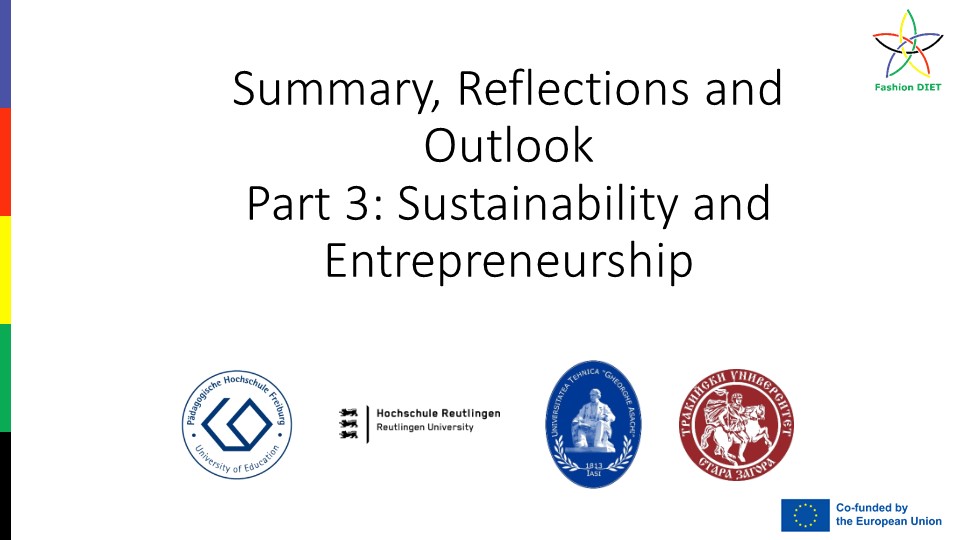
The fashion industry is a mature, extremely globalized and labor-intensive sector with strong competitive pressure, short life cycles and low predictability. Since the late 1990s and early 2000s fashion firms started to more frequently refresh their fashion lines to meet the rapidly changing preferences of consumers. This trend has further accelerated through the emergence of e-commerce which provides consumers the unrestricted ability to immediately purchase new clothes. Retailers now constantly flood the market with new mass-produced fashion items that are fashionable, affordable and easily accessible for consumers who desire to follow the latest high fashion trends but for a fraction of the traditional price. However, this business model is extremely resource-intensive and causes significant environmental impact.
The negative effects of fashion on the natural environment have further intensified through consumers’ propensity to overconsumption and short-term use of clothes. The falling prices, the immediate availability and the deteriorated quality of fashion items have encouraged a “throwaway culture” among consumers with many clothes being disposed before their effective lifetime has ended. In the previous lectures a short overview of the most important underlying mechanisms were discussed. After running through the lectures, students should have a basic understanding of the interaction between companies and consumers in a highly globalized world and why this causes severe negative impact on the environment. Students should be able to reflect the reasons and – based on this – discuss potential solutions.
Marcus Adam & Jochen Strähle
Content:
-
Please find below the PDF document of the lecture “Summary, Reflections and Outlook - Part 3”.
The document contains notes by the author.
-
850.0 KB PowerPoint Präsentation Uploaded 10/03/23, 12:22
Please find below the PDF document of the lecture “Summary, Reflections and Outlook - Part 3”.
The document contains notes by the author.
-
Here you can download all documents of the lecture in a bundle:
-
Please give us your Feedback on the Lecture “Summary, Reflections and Outlook - Part 3”.
-